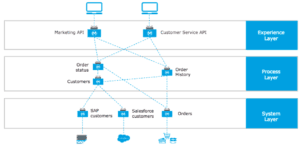The pace of change in customers’ expectations in an always-on, always-connected world has never been higher.
We’re living in a world where customers have on average three connected devices, spend about four hours a day on their phone and about one third of their time online is spent on social channels. Thus, we need to consider how to engage customers through these new channels. And all of these devices and channels create an immense amount of valuable data and signals that we should capture, analyze, and apply to deliver the exceptional brand experiences that customers expect.
But despite their best efforts, most companies struggles to deliver on these expectations. The consequences of falling short are that marketers must search across disconnected data sources and departments to get a complete picture of the customer while navigating disparate tools to execute multi-channel campaigns. The same goes for customer service agents trying to help their customers.
And these issues are causing customers to think twice when engaging with brands. In fact, 52% of consumers will switch brands if they receive communications that are not personalized to them. The question for every company becomes: How will you connect your data, departments, and channels to deliver the experiences that customers expect in order to win in this competitive landscape?
A single view of customers accelerates growth
It’s almost become cliche, but we’ve all suffered through the experience of calling customer support, only to have to repeat our names and other identifying information to multiple service agents as we’re passed along to various departments, or put on hold while the agent searches through multiple computer systems to answer our question.
From a marketing standpoint, a single view of customers allows us to engage prospects and customers at the right time to move him or her through the customer journey. And by analyzing and identifying patterns, we can optimize our business processes, communications, and recommendations to align with our customers’ preferences. From a service standpoint, not only does a single view of customers enable quick resolutions to customers’ issues while maintaining high satisfaction, but it also opens up a new channel for reps to cross-sell.
According to Gartner, less than 10% of businesses have achieved a single view of their customers
And that’s due, in large part, to using strategies that don’t scale as the business requirements change. For the 90% of companies that are struggling to achieve a single view of their customers, we tend to see three common approaches:
- Manual data extracts: Not only are these incredibly time-consuming, but they are also highly prone to human error
- Point-to-point integrations: As the business evolves, these hard-coded, brittle connections resulting in unmanageable spaghetti code
- Master data management: While helpful in some scenarios, MDM, by itself, is insufficient
Why MDM is insufficient
Architecturally, master data management (MDM) is a reference database housing master data and is used as a middleware or ESB, for which its mandate is to link and synchronize customer data across business applications. And to be clear, MDM, done correctly, can provide tremendous value, including being leveraged as an input to building a single view of customers. But while your data may be reliable with MDM, MDM initiatives suffer from the following:
- Slow: They can take over a year without delivering a complete customer view that the business finds useful, often because various stakeholders don’t agree on the approach
- Missing non-master data: The purpose of MDM is to manage master data, only, but you’ll need non-master data to truly provide a single view of customers
- Not action-oriented: MDM only manages master data – it it does not enable taking action on that data, let alone automating entire business processes
And because MDM is generally inflexible, people will find ways around it.
Our customers have changed paradigms from a system-centric approach to a domain-driven approach
Instead of thinking about aggregating data from Salesforce, SAP, and, say, a mainframe system, a domain-centric approach means aggregating the customer domain, the product domain, the billing domain, etc. Domains can be built without being reliant on MDM. As an example, in a “behavioral data” domain, you may ask questions such as: Did a customer watch a particular video? How much time are they on mobile? What’s the frequency of their store visits? What’s in their cart? These non-MDM data are invaluable and will help you drive customer engagement.
With an API-led approach, enabled by the MuleSoft Anypoint Platform, APIs are used not only to abstract data from systems, but also to orchestrates across those systems, processing that data to validate, enrich, and connect, providing a secure, controlled method for granting access to the right people. And because companies typically have multiple customer experience initiatives running in parallel, an API-led approach allows you to achieve greater speed and scale while driving a consistent customer experience by reusing the same API assets.
An API-led approach enables APIs to serve as the foundation to building a flexible application network — adding new experiences, applications, and systems is as simple as merely plugging into the network without re-architecting the entire IT landscape. The result of this approach is that subsequent projects actually accelerate, due to leveraging previously-built APIs. Ultimately, instead of focusing on connectivity, systems, and data, your team can focus on supporting the business initiatives that drive innovation and customer engagement.

How PetSmart’s application network connects customers and their pets to associates
PetSmart, the largest specialty pet retailer, employs over 53,000 associates, operates over 1,400 pet stores in the US, Canada, and Puerto Rico, and over 200 in-store dog and cat boarding facilities, providing pet supplies, training, grooming, boarding, daycare, and adoption services. Having acquired five other brands, PetSmart needed a scalable means of providing a world-class customer experience by way of a single view of their customers across their entire portfolio.
PetSmart partnered with MuleSoft to realize this vision, and by adopting an API-led approach, PetSmart reduced API development from what used to take eight weeks down to two weeks.
PetSmart’s Customer Profile API is a powerful component of their digital transformation and customer engagement strategy. In conjunction with other APIs, the Customer Profile API connects to their Booker system, logging grooming appointments with customers for their pets while informing employees of the appointment details. Further, the Customer Care team can now offer highly-targeted care services, and the Marketing team can send highly-targeted campaigns, incentivizing customers to sign up for online services. Finally, in their retail stores, PetSmart calls the Customer Profile API at the point of sale in conjunction with the Point-of-sale Customer Lookup API to offer discounts and promotions in real time. And it’s important to remember, PetSmart is doing this across each of their six brands, with the flexibility to scale with any new brands they may build or acquire in the future.
Scaling your omnichannel experience with MuleSoft
MuleSoft’s Anypoint Platform is purpose-built to deliver on the capabilities required for your Single view of customers strategy: it’s the unified platform for API-led connectivity that enables you to build an application network of apps, data and devices through APIs and integrations. Whether deployed on-premises, in the cloud, or in a hybrid environment, Anypoint Platform enables:
- Speed of delivery: Connect to systems faster using our 170+ out-of-the-box connectors and easy-to-use drag-and-drop integrated development environment.
- Actionable visibility: Run detailed analytics and gather insights about your application network to optimize your approach.
- Security by design: Anypoint Platform supports best-in-class security standards trusted by leading brands across every industry.
- Future-proof architecture: As your business evolves, enjoy the flexibility to easily embrace new channels and technologies.
- Intentional self-service: MuleSoft allows you to scale 4x faster with out-of-the-box connectors and reusable APIs that other developers across the organization can leverage.
Watch this Webinar to learn how MuleSoft’s Anypoint Platform will enable you to use APIs to build your single view of customer architecture so that you too can increase agility and drive innovation for your customers.









